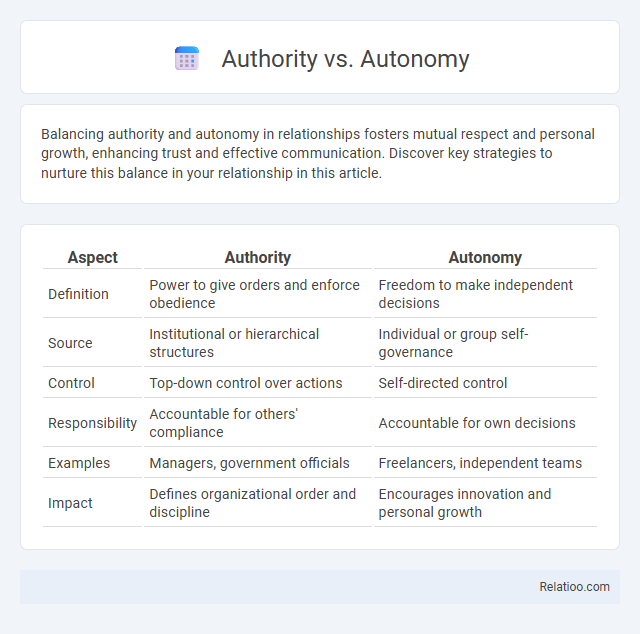Balancing authority and autonomy in relationships fosters mutual respect and personal growth, enhancing trust and effective communication. Discover key strategies to nurture this balance in your relationship in this article.
Table of Comparison
| Aspect | Authority | Autonomy |
|---|---|---|
| Definition | Power to give orders and enforce obedience | Freedom to make independent decisions |
| Source | Institutional or hierarchical structures | Individual or group self-governance |
| Control | Top-down control over actions | Self-directed control |
| Responsibility | Accountable for others' compliance | Accountable for own decisions |
| Examples | Managers, government officials | Freelancers, independent teams |
| Impact | Defines organizational order and discipline | Encourages innovation and personal growth |
Understanding Authority and Autonomy
Understanding authority involves recognizing the legitimate power structures that guide behavior and decision-making within societies, organizations, or institutions. Autonomy refers to your ability to make independent choices and exercise self-governance, balancing personal freedom with external regulations. Navigating the tension between authority and autonomy requires awareness of societal norms that influence acceptable limits and responsibilities.
Defining Authority in Modern Organizations
Authority in modern organizations is defined as the legitimate power granted to individuals or groups to make decisions, enforce rules, and direct resources towards achieving organizational goals. It is structured through formal hierarchies and roles, ensuring accountability and coordination within complex systems. The balance between authority and autonomy influences organizational efficiency, with societal norms shaping expectations around compliance and individual discretion.
The Core Principles of Autonomy
Autonomy centers on the principle of individual self-governance and the capacity to make informed, uncoerced decisions, emphasizing personal freedom and responsibility. It contrasts with authority, which involves external control or mandates, and societal norms, which are collective expectations shaping behavior. Core principles include respecting individual choice, ensuring informed consent, and promoting the right to pursue one's own values within a social framework.
Authority vs Autonomy: Key Differences
Authority refers to the acknowledged right or power of an individual or institution to make decisions and enforce obedience, often structured within hierarchical systems. Autonomy signifies an individual's capacity for self-governance, making independent choices free from external control or influence. The key difference lies in authority imposing rules through recognized legitimacy, while autonomy emphasizes personal freedom and self-determination within or outside societal frameworks.
Benefits of Authority in the Workplace
Authority in the workplace establishes clear roles and responsibilities, enhancing organizational efficiency and decision-making speed. It provides a structured environment where employees understand expectations, leading to increased productivity and accountability. Strong authority also facilitates effective conflict resolution and consistent enforcement of policies, promoting workplace stability.
Advantages of Fostering Autonomy
Fostering autonomy enhances individual motivation, creativity, and personal growth by allowing you to make choices aligned with your values and interests. It promotes higher satisfaction and psychological well-being, reducing dependence on external control found in authority-driven settings. Encouraging autonomy supports a flexible balance with societal norms, enabling adaptive and innovative contributions within a community.
Challenges of Balancing Authority and Autonomy
Balancing authority and autonomy presents challenges such as maintaining organizational control while fostering individual independence, which can lead to conflicts when employees seek creative freedom but must adhere to established rules. Excessive authority may suppress innovation and motivation, whereas too much autonomy can result in inconsistent decision-making and reduced accountability. Navigating these tensions requires clear communication, flexible policies, and a culture that respects both hierarchy and personal empowerment.
Real-World Examples: Authority vs Autonomy
In workplaces, authority typically manifests as managerial control over employees' tasks and deadlines, ensuring organizational goals are met. Conversely, autonomy allows individuals like freelancers or remote workers to set their schedules and choose methods for completing projects, enhancing creativity and job satisfaction. Your ability to balance respect for authority with personal autonomy often determines professional success and fulfillment.
Strategies for Harmonizing Authority and Autonomy
Balancing authority and autonomy requires implementing clear communication channels and establishing mutually agreed-upon boundaries that respect individual freedoms while maintaining organizational or societal order. Strategies such as participative leadership, where decision-making involves collaborative input, and creating flexible guidelines that adapt to changing contexts empower Your sense of ownership without undermining established power structures. Leveraging conflict resolution mechanisms and fostering a culture of trust ensures that societal norms evolve in harmony with personal autonomy and authoritative frameworks.
The Future of Authority and Autonomy in Leadership
The future of authority and autonomy in leadership is defined by a shift towards decentralized decision-making, where leaders balance hierarchical power with individual empowerment to drive innovation and adaptability. Emerging trends emphasize fostering autonomy within teams while maintaining strategic authority to align goals and ensure accountability. As societal norms evolve, effective leadership increasingly requires integrating diverse perspectives and ethical considerations to build trust and sustainable organizational cultures.

Infographic: Authority vs Autonomy
 relatioo.com
relatioo.com